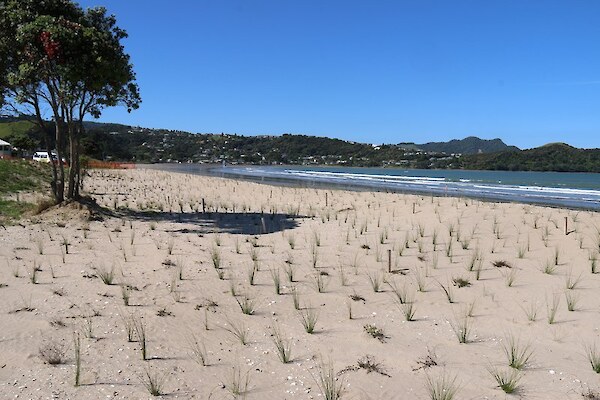Koi Carp project update
The Waikato Regional Council and Coastal Restoration Trust are evaluating the use of digested koi carp in a range of products for positive environmental gains in community-based restoration initiatives. This projects has been funded by the Ministry for the Environment’s Community Environment Fund with support from Waikato Regional Council, local community Beach Care groups, and Coastal Restoration Trust research partners. This has included ongoing evaluation of digested koi carp as an organic fertiliser option for boosting performance of the native plants on dunes as part of dune restoration programmes:
-
 Incorporating koi carp pellets within the planting hole during planting;
Incorporating koi carp pellets within the planting hole during planting; - Comparison with the current fertiliser practice at planting using a slow-release fertiliser tablet;
- Evaluating the effects on a range of species including the sand binders spinifex and pingao, and mid-dune species pohuehue and wiwi;
- Evaluation of seaweed-derived fertiliser formulations developed by AgriSea as pellets applied in combination with koi carp or on its own; and
- For pingao, fencing at the Port Waikato site to exclude rabbits which have been difficult to control and have compromised earlier trials.
 Initial post-planting survival assessment indicates favourable performance of the organic koi carp options as compared to the standard fertiliser regimes. A full first year assessment will be carried out this winter. Further fertiliser trial sites have been arranged for extending planting and fertiliser treatments.
Initial post-planting survival assessment indicates favourable performance of the organic koi carp options as compared to the standard fertiliser regimes. A full first year assessment will be carried out this winter. Further fertiliser trial sites have been arranged for extending planting and fertiliser treatments.
The digested carp produce several components and by-products including a dry powder that can be pelletized, a nutrient-rich liquid (fish juice), and a lower-nutrient condensate. Other potential uses for koi carp were presented to the Coastal Restoration Trust’s Annual Conference held in Petone in March 2018.
Planning is well underway in setting up trials to evaluate potential uses for various formulations of digested koi carp that could be used by community groups. The uses being investigated include:
- Animal repellent – applied to foliage of palatable planted natives to deter browsing by rabbits (single largest killer of natives on dunes!) and other feral animals, inadvertent grazing by stock.
- Rodent bait – rodents are attracted to digested carp so excellent scope to manufacture moulded bait and chew cards as lures for control operations targeting rodents and mustelids to reduce predation of roosting and nesting birds, native skinks and invertebrates, and loss of seed crops of threatened natives.
- Nursery propagation – early trials indicate digested koi carp is an excellent additive to potting mix in the propagation of native, also potential liquid fertiliser.
- Fungal and insect control – Various potential uses of condensate and fish juice in foliar protection of planted natives.
- Carbon/organic matter – preliminary investigation indicates bio-char from willows of the same waterways infested with carp can be mixed with digested koi carp to reduce the smell and boost carbon storage to mitigate expected impacts of climate change.

Dr Bruno David of the Waikato Regional Council has led the publication of a paper in the Journal of Applied Ecology - “The CarP-N neutral Project”: Removal, processing and reuse of invasive fish in local terrestrial conservation projects (Bruno David, Deniz Özkundakci, Michael Pingram, David Bergin and Michael Bergin 2018).
The paper presents two studies. The first study is based on early results from the current dune fertiliser trials as part of this Coastal Restoration Trust project and describes the use of processed invasive fish as a replacement for imported synthetic fertiliser tablets. The second is the potential use of invasive fish material as a lure in trapping programmes to control other introduced pests (e.g. introduced rats and mustelids) which will be further evaluated as part of this project.
A poster for display at conferences, workshops and Coast Care events has been produced on this koi carp project and can viewed on the Coastal Restoration Trust’s website www.coastalrestorationtrust.org.nz
Posted: 4 May 2018 in the News category
